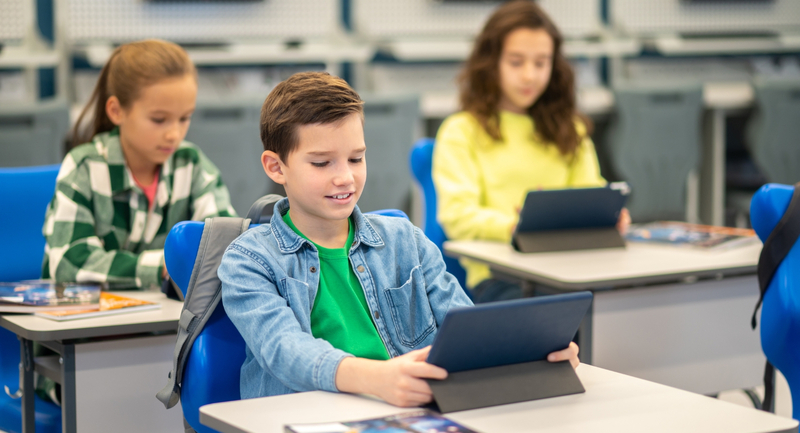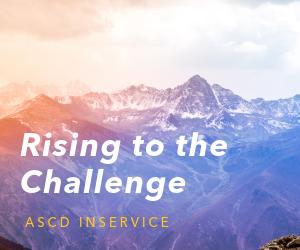I sat in a faculty meeting after school one day watching a TedTalk called “The Myth of the Average.” The question posed after watching the video was: What aspects of classroom practice are “designed for the average” that could be re-envisioned to make school more engaging—to make more students want to come to class and school?
There is much work to be done when it comes to curriculum and instruction to make academic success more accessible, relevant, and innovative to students. I could list many areas in my own classroom teaching that could be improved in this regard.
At the same time, however, when thinking about innovation in the classroom, I cannot help but consider the limitations I work with as a teacher: a 54-minute class school schedule, class sizes of 28 students, a 30-desk traditional classroom setup, to name a few. How much innovation can occur within a system that itself needs reimagining?
It is with these questions in mind that I argue that school itself—the system, the five-day school week, the start time, the class period schedule—is “designed for the average.” As we engage in conversations about addressing absenteeism and student engagement, teachers, educators, administrators, parents, policymakers, and researchers need to, in conjunction with improving classroom practice, also look beyond the classroom.
The Endless Cycle of Catching Up
Recent data paints a clear picture: Post-pandemic absenteeism and chronic absenteeism rates have soared. High rates of absenteeism link to less academic success, a higher chance of dropping out of school, and a higher chance of being unemployed as an adult. Even prior to the pandemic, the number of school-aged students struggling with mental health was on the rise. Additionally, pre-pandemic research points to school start times as disruptive to adolescent student sleep patterns and mental and physical health. Studies show that adolescents with chronic fatigue syndrome or sleep deprivation demonstrate higher rates of absenteeism, reduced quality of life, reduced school participation in classes and extracurriculars, reduced academic performance, and less social connection at school. According to research, 60 to 70 percent of adolescent students are sleep deprived. It is no wonder, then, that absenteeism rates are higher—the way the school day is set up does not promote strong engagement within school hours.
My own anecdotal experience as an 11-year high school English teacher reinforces this landscape. In the past few years, I have observed more students than ever missing significant amounts of school across the various grades and levels of classes that I teach. I cannot remember the last time I had full attendance in one of my five classes, never mind all of them. In addition to teaching my standard classes, the amount of time I spend re-teaching has significantly increased. For many students, school feels like an endless cycle of trying to catch up, and for teachers, it feels like an endless cycle of catching students up.
The way the school day is set up does not promote strong engagement within school hours.
What students take on after school has increased as well, especially in terms of part-time jobs. Between homework, extracurricular clubs, sports, and work, their commitments to valuable endeavors outside the classroom have many students overwhelmed and stressed.
Recently, I was working one-on-one after school with a student who had missed several days of class. She broke down into tears, having just come from a meeting where she had been issued a warning about her excessive absences and tardies. In addition, to make the after-school meeting with me, she had to give up her shift at work. She said that between homework and her two part-time jobs, she often doesn’t even begin to wind down until later at night. Because she has so much going on, she has trouble falling asleep, does not fall asleep until around 2 a.m., and then cannot get up in the morning to get to school on time. She said, “I love your class Ms. Nerlino, but if it’s between your class and sleep that I desperately need, why is it a bad thing that I’m prioritizing my health?”
Two Key Steps to Reshaping Education
What lesson, no matter how engaging, can possibly transcend the legitimate mental and physical health issues that students face? Are we looking at classroom lesson design and ignoring the larger system in which the classroom itself exists?
It is within the context of these ruminations that I offer two suggestions—examining our beliefs about learning and rethinking our priorities—to re-envision schools in a comprehensive and profound way.
Examining Our Beliefs About Learning
The pandemic has not only drastically shifted my beliefs about learning, but it has also changed a lot about what I value, assign, and do in my classroom. These changes are clearest when I plan lessons and units.
I use monthly calendars to plan my classes, so I map out for the month roughly what we will do in class each day and the homework for each night. When making the current year’s calendars, I often look back at that previous year’s to decide what worked well and what I want to change. For example, one year I thought that our class discussion of The Narrative of the Life of Frederick Douglass had gone well from a student participation and engagement standpoint, but I felt we needed another text to help the discussion dive into how the racism Douglass faced has shaped the current landscape. I introduced excerpts of Clint Smith’s How the Word Is Passed into the unit for this purpose; consequently, I had to pare down some of the practice paragraphs I had students write in the subsequent unit for time purposes. This change made sense in terms of creating more opportunities for discussion and sociocultural learning and cutting down on the amount of writing-based work. In the years since the pandemic, I have significantly pared down what did not fit anymore and thought about how “covering” as much content as possible no longer means "good teaching" to me.
'Covering' as much content as possible no longer means 'good teaching' to me.
My priority in creating the calendars is to assign only the work that I deem completely necessary to students’ learning in my class. I have found that by eliminating outdated lessons and assignments, students get more out of what I do assign. As I engaged in this process, my priorities became simpler: facilitate student thinking and provide opportunities for students to connect with one another through reading and writing.
Just as I, a classroom teacher, partake in this work, so must our schools as systems engage in reflection to pare down the outdated aspects that might no longer work. For example, in the high school setup, the five-school day week with seven hours a day of classes followed by homework for each class does not seem to serve students anymore; it does not seem to promote deep and meaningful engagement with learning or good wellness habits.
Rethinking Our Priorities
Much of the narrative about pandemic-induced academic losses and the related discourse about student learning forced me to rethink my beliefs about why and how learning occurs. Perhaps, since this global mega event, students learned different things. Perhaps some of what they used to learn is no longer relevant. Perhaps meaning and depth and connection through learning is now more important than content coverage.
In my own post-pandemic 12th grade classroom, during the last term, with the two major paper units occurring earlier in the year, it no longer made sense to write yet another paper after reading and discussing Hamlet. I swapped out the final paper for a unit that has students use similar research skills to explore arguments for and against keeping Shakespeare in the high school curriculum, consider these arguments in light of their own goals for learning and experience with Shakespeare in high school, and engage in a lively debate about the value of this canonical author.
Parallel to adapting priorities in the classroom, on a systemic level, perhaps it is necessary to make time, energy, and space to prioritize a curriculum that teaches students about physical and mental health, breeds social connection, and shows the relationship between academic subjects and human connection. Why not reconfigure schools to make these priorities central to the school day? For example, how does the system promote student access to mental wellness and health resources when students have to fit in school counseling appointments during academic classes? Why not have dedicated time for students to access these supports? Why not normalize it?
What can we do on the school level to adapt to the current needs of the students we serve?
Adapting Systems to Students
Beginning to look at our beliefs about learning, what counts as learning, and what our priorities are for students might help us as an educational community re-envision school in a way that promotes student health and well-being as well as learning in its broadest sense.
The statistics related to adolescent absenteeism, mental health challenges, sleep deprivation and more speak for themselves, and the way that I see them playing out on the day-to-day level begs the question: What can we not only do on the classroom level but the school level to adapt to the current needs of the students we serve?
There is not a “right” answer to this question, and we need to ask more questions to construct solutions that approach the issue of absenteeism in a comprehensive way. And as we explore solutions and ideas, we must look within and beyond the classroom because what is at stake—student investment in school—is too critical to ignore.








